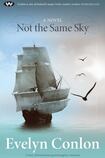
In October 1849, a ship called the Thomas Arbuthnot set sail from Plymouth for Australia. Its main cargo was a group of Irish girls, orphans, who were being dispatched to the antipodes to work as servants and farmhands. They had been recruited from poorhouses all over Ireland by Charles Strutt, a surgeon who supervised their voyage. During a few years following the Famine, 4,000 Irish girls, orphans, were shipped to Australia in this way. Refugees? Or slave girls?
Evelyn Conlon has used the diary of Charles Strutt and other archival and secondary sources as the basis of her imaginative and thoughtful reconstruction of the voyage of the Thomas Arbuthnot, and of the subsequent fate of a small selection of the transported orphans: Honora, Julia, Bridget and Anne.
The story is told from their various points of view, and to a large extent from that of Charles Strutt himself. The historical narrative is framed by a present-day story of a sculptor of headstones, Joy Kennedy, who has been commissioned to carve a memorial to the Irish orphans in Sydney, and so is a hired girl of a modern kind, whose plane journey (a splendid account) counterpoints brilliantly the sea voyage undertaken 150 years previously.
What is most striking about Conlon’s novel is its tone. The Famine, orphans, forced emigration: these themes traditionally inspire sighs, tears and sentimentality. But Conlon confounds expectations and puts an utterly unpredictable and very original spin on this fascinating story. Charles Strutt, far from being a Dickensian villain, is a kind and civilised man. The beauty of the individual can occasionally illuminate, even in the nightmare of mid-19th-century Irish history.
Strutt uses the three-month voyage to improve the girls’ physical condition, to educate them, to train them in the ways of well-run households. (Of course, it’s in his interest that they arrive at the hiring fairs of Sydney in good health, but he encourages them to enjoy life.) You expect, on an 1848 ship to Australia, some cruelty, starvation, burials at sea. Instead there are baths, English classes, dancing, a party when the ship crosses the Equator, a sense of harmony. Tellingly, and delightfully, Conlon does not succumb to the temptation to introduce a storm at sea. This ship makes its way in reasonable conditions to its destination – this must have happened in fact sometimes, but fiction seldom treats us to a calm crossing.
Expectations are also refreshingly confounded in the characterisation of the girls. They are not those wailing waifs so familiar from the endlessly reproduced drawings in the London Illustrated News, dehumanised by misery. While in no way undermining the horror of the Famine, Conlon portrays Julia, Honora, Bridget and Anne, who survived it, as normal girls. One is wild, one is clever, one is anxious, one is cheerful. We are reminded that 19th-century people may not have been all that different from us. They are intelligent, and curious about the new country. They admire colourful birds and flowers, and ask questions about the stars. And they are articulate, in two languages. They don't speak some ghastly gobbledygook stage-Irish, these people who spoke fluent Irish to begin with and mostly learned English en route. In short, Conlon chooses not to patronise her characters.
The novel is written from various points of view but in the third person and in the sprightly, ironic, fresh tone that is this writer's hallmark. She has a wonderfully distinctive voice – it will be familiar to many, in its oral manifestation, from her excellent contributions to Sunday Miscellany. The same unique voice colours her every written word: down to earth, questioning, sometimes witty, sometimes gentle and lyrical.
The novel has many sombre moments, as when Joy Kennedy, the contemporary character, is sickened at the discovery of the cruelty with which the colony was run in the 19th century. The girls, when they arrived in Sydney, would have seen the regular public floggings of people charged with minor infringements of rules. The question of the right of the Irish to colonise the lands of the aboriginals is touched upon. But, above all, what is considered is the impact of forced emigration: what sort of character could prosper in a new country, far from home, and following unconscionable loss? It is pointed out by one of the orphans that there is little value in dwelling on the horrors of the past. She has to focus on the future. That is always the survivor’s strategy. But she has found, somewhere, Aeschylus’s line: “He who learns must suffer. . . and in our own despair comes wisdom by the terrible grace of God.”
Is it really desirable, or even possible, to forget trauma? Joy Kennedy, the sculptor, wonders what the memorials are for: “Are they to let us know? To make us accept? Or to make us weep?” The real Famine survivors tended to suppress the memory of what happened, understandably. But why do we yearn to “remember” what we did not have to endure?
These, and many other profoundly important questions are raised in this, Evelyn Conlon’s seventh volume of fiction. It is a rich, intelligent and complex novel, carefully researched, beautifully written and utterly compelling.
Éilís Ní Dhuibhne is a novelist and short story writer, and a member of Aosdána











